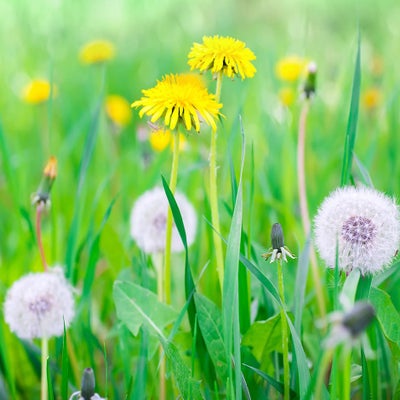
Quick facts
Dandelion’s botanical name is Taraxacum
Botanists have identified over 200 micro-species of Taraxacum in the UK; close inspection is needed to tell them apart
The nectar-rich flowers are loved by bees and butterflies and the seeds are eaten by small birds
Dandelions are evergreen perennials with a main taproot
If you choose to remove dandelions, non-chemical methods are effective
What do dandelions look like?
There are, in fact, many species of dandelions growing in the UK. Thankfully, they share many characteristics and all can be distinguished by the following:
- Yellow flowerheads packed with petals are borne on fleshy, hollow stalks from March to October
- Seedheads are globe-like (‘dandelion clocks’), composed of many silvery seed-bearing structures that disperse in the wind
- Evergreen rosette of leaves, growing from a main
- The rosette is typically 15-30cm (6-12in) wide and is often flat, especially in lawns, but leaves can grow upwards if allowed
- Leaves are long, narrow and often lobed. This is highly variable, even within the same plant. Some leaves have a pinkish-purple colouring near the base
- Leaf stems and flower stalks exude a milky latex when damaged

Did you know?
The BSBI (Botanical Society of Britain and Ireland) recognises Taraxacum as a particularly interesting genus. Many species are native to the UK, and some are endemic (only found in the UK). For anyone wanting to learn more about identifying sub-groups (sections) and species of dandelion, the BSBI website is a great resource.
Are dandelions weeds?
Dandelions are now known to have many benefits and uses, transforming gardeners’ opinions from weed to wildlife plant.
Their value to wildlife, providing food to many insects and birds, is perhaps the main reason why they should be welcomed in our gardens. Their nectar- and pollen-rich flowers appear over a long period and are loved by bees and butterflies – which is why dandelions are included on the RHS Plants for Pollinators list. The early flowers are especially valuable as they provide food at a time when other sources are scarce. The seeds that follow provide food for bullfinches, greenfinches, goldfinches and serins.
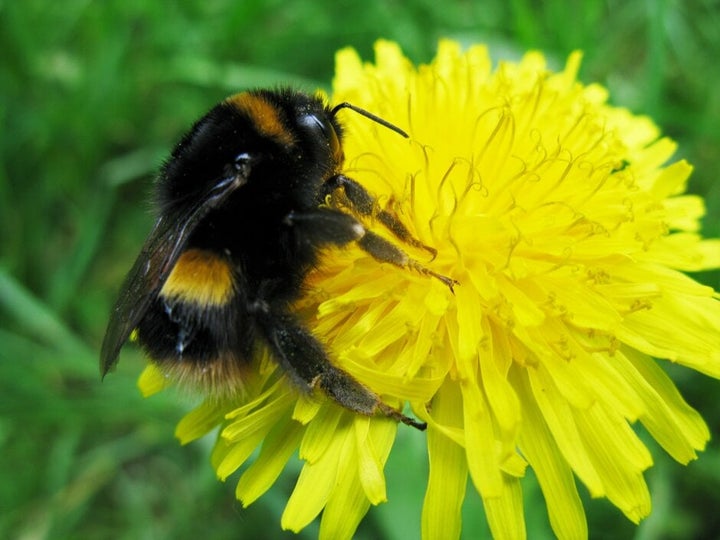
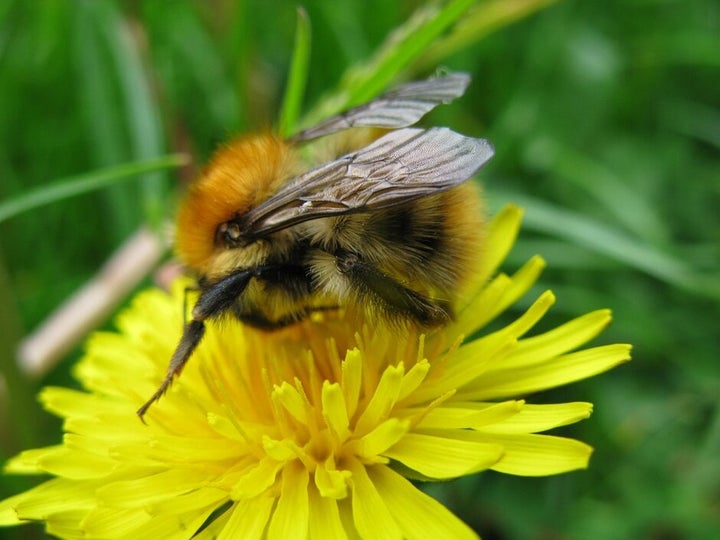
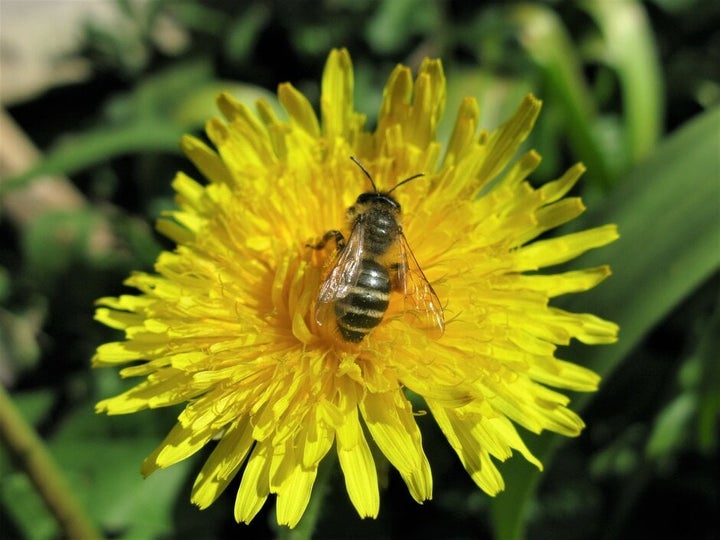
Did you know?
Many caterpillars eat dandelion leaves, including those of buff ermine, white ermine, dot, garden tiger, ruby tiger, riband wave and yellow shell moths.
Dandelions have ornamental value, being a cheerful addition to flower-rich lawns, verges and wildlife gardens. Their leaves, flowers and roots are edible and people have found many ways to benefit from the flavours and nutrients. Dandelions also have a long history of medicinal use and are still used in many herbal remedies to treat a range of ailments.
Gardeners still wishing to maintain a fine, are, however, likely to consider dandelions as weeds. In borders and beds too, gardeners might want to limit their numbers if they are growing small or young plants that could be swamped or outcompeted by dandelions.
What is a weed?
The term ‘weed’ describes a plant that is growing where it isn’t wanted. Weeds usually thrive in average garden conditions, reproducing and spreading easily. It is up to you to decide what you call a weed and what you choose to retain or remove.
Frequently asked questions about controlling dandelions
Here are our answers to your most common questions about dealing with dandelions:
How invasive are dandelions?
As anyone who has blown a ‘dandelion clock’ will know, these plants spread by seed. A single flowerhead actually contains over a hundred individual flowers packed closely together, which in turn become over a hundred seeds. The wind will detach and disperse the seeds and these can travel up to 500m (1,640ft) away from the parent plant.
The good news is that deadheading some of the dandelions in your garden, as the flowers begin to fade, will reduce the amount of new . The seeds themselves aren’t particularly long-lived (after three months only half will still be viable) and not all the seeds will land in a place suitable for .
Young dandelion plants quickly develop a to become established and plants can regenerate from sections of root, so may be spread unintentionally by gardeners composting roots or chopping them up when digging. Taking care to separate these before and being mindful of where you dig will help to reduce their spread.
Do I need to get rid of dandelions?
No – allowing dandelions to grow in your lawn, wildflower meadow, wildlife corner or in less-cultivated areas is a great way to boost the of your garden. You could even grow a small patch in your veg beds to encourage pollinators to your crops and to use for harvesting.
You can control the spread of dandelions by deadheading and removing any seedlings that appear out of bounds, so there is space in almost all gardens for this valuable . You may, however, want to remove those growing in fine lawns or highly cultivated beds and borders.
Top Tip
Make use of the dandelions you choose to dig up. Add young, tender leaves to salads and cook older ones. Use flower buds as an alternative to capers or use open flowers to make a pleasant tea. Harvest roots to flavour soft drinks or use them dried and roasted as a caffeine-free coffee substitute.
What is the easiest way to kill dandelions?
If you can’t tolerate all the dandelions in your garden, there are ways to remove them:
- Dig or fork out plants – ideally do this when plants are still young and haven’t had time to develop a deep taproot or set seed. Aim to remove as much of the taproot as possible because dandelions can regenerate from fragments of root. With particularly deep-rooted or awkwardly positioned plants, initially remove as much root as you can and then remove regrowth when it appears – over time this will weaken the plant. Taproots can extend down a long way but are typically less than 30cm (1ft) long in gardens; they tend to branch and fork in stony ground. There are many specially designed tools, often sold as ‘dandelion weeders’, to help with removal; these target the taproot and limit soil disturbance.
- Mulch – apply a layer of organic matter, about 7.5cm (3in) deep, to beds and borders in late winter to reduce the amount of seedlings. This will also reduce the germination rate of any subsequent seed landing on the ground, especially if the organic matter is free-draining.
- Smother plants – in areas containing large numbers of unwanted dandelions, cover the ground with a layer of cardboard and then a 20cm (8in) thick layer of organic matter, such as or wood chips. Alternatively, use a heavy grade matting. This will block light and prevent growth, causing the root to die. Keep soil covered for a few years to ensure this method is effective.
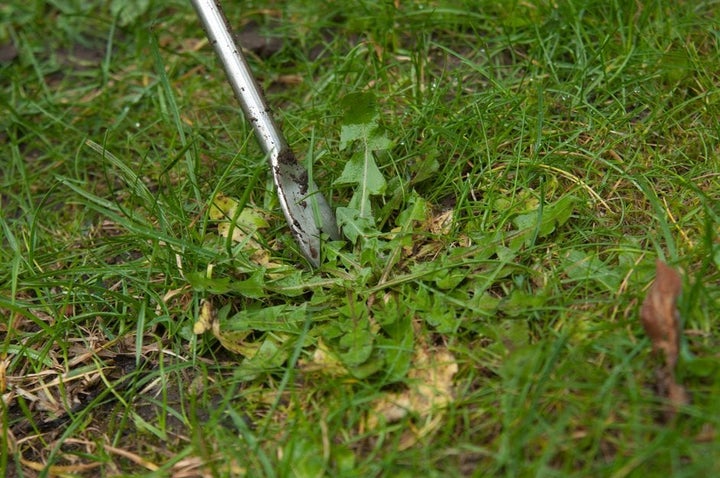
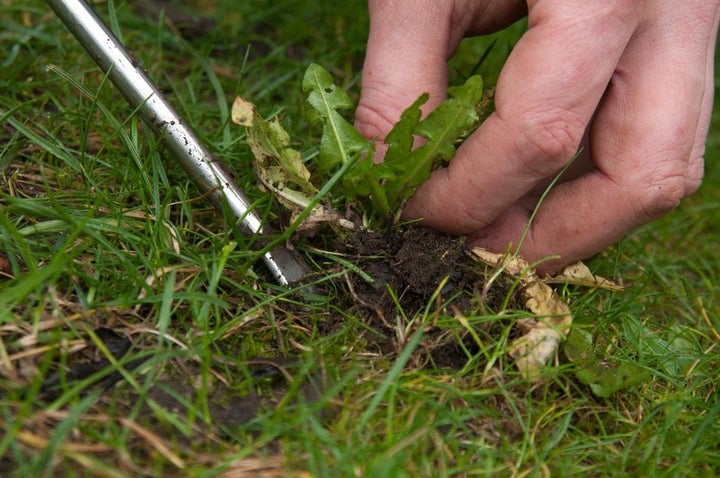
Top Tip
You can add dandelion leaves to your home compost bin, but don’t add roots as these need high temperatures to be destroyed. Add them to your council green waste recycling bin or lay them on some sunny paving until they are completely dried and dead.
Should I use weedkiller?
No – as non-chemical control methods are effective, even if time-consuming, there is no need to use a weedkiller. Selective weedkillers used on lawns to kill dandelions remain in the soil for some weeks after application and have been linked to cases of herbicide contamination.










